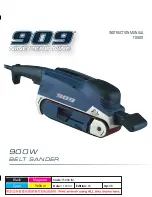
4
4) Power tool use and care
a) Do not force the power tool. Use the correct
power tool for your application.
The correct
power tool will do the job better and safer at the rate
for which it was designed.
b) Do not use the power tool if the switch does
not turn it on and off.
Any power tool that cannot
be controlled with the switch is dangerous and must
be repaired.
c) Disconnect the plug from the power source
and/or remove the battery pack, if detachable,
from the power tool before making any
adjustments, changing accessories, or
storing power tools.
Such preventive safety
measures reduce the risk of starting the power tool
accidentally.
d) Store idle power tools out of the reach of
children and do not allow persons unfamiliar
with the power tool or these instructions
to operate the power tool.
Power tools are
dangerous in the hands of untrained users.
e) Maintain power tools and accessories. Check
for misalignment or binding of moving parts,
breakage of parts and any other condition
that may affect the power tool’s operation.
If damaged, have the power tool repaired
before use.
Many accidents are caused by poorly
maintained power tools.
f)
Keep cutting tools sharp and clean.
Properly
maintained cutting tools with sharp cutting edges
are less likely to bind and are easier to control.
g) Use the power tool, accessories and tool bits
etc. in accordance with these instructions,
taking into account the working conditions
and the work to be performed.
Use of the power
tool for operations different from those intended
could result in a hazardous situation.
h) Keep handles and grasping surfaces dry, clean
and free from oil and grease.
Slippery handles
and grasping surfaces do not allow for safe handling
and control of the tool in unexpected situations.
5) Battery tool use and care
a) Recharge only with the charger specified
by the manufacturer.
A charger that is suitable
for one type of battery pack may create a risk of fire
when used with another battery pack.
b) Use power tools only with specifically
designated battery packs.
Use of any other
battery packs may create a risk of injury and fire.
c) When battery pack is not in use, keep it away
from other metal objects, like paper clips,
coins, keys, nails, screws or other small metal
objects, that can make a connection from
one terminal to another.
Shorting the battery
terminals together may cause burns or a fire.
d) Under abusive conditions, liquid may be
ejected from the battery; avoid contact. If
contact accidentally occurs, flush with water.
If liquid contacts eyes, additionally seek
medical help.
Liquid ejected from the battery may
cause irritation or burns.
e) Do not use a battery pack or tool that is
damaged or modified.
Damaged or modified
batteries may exhibit unpredictable behaviour
resulting in fire, explosion or risk of injury.
f)
Do not expose a battery pack or tool to fire
or excessive temperature.
E
xposure to fire
or temperature above 130 °C (265°F) may cause
explosion.
g) Follow all charging instructions and
do not charge the battery pack or tool
outside the temperature range specified
in the instructions.
Charging improperly or at
temperatures outside the specified range may
damage the battery and increase the risk of fire.
6) Service
a) Have your power tool serviced by a qualified
repair person using only identical replacement
parts.
This will ensure that the safety of the power
tool is maintained
.
b) Never service damaged battery packs.
Service
of battery packs should only be performed by the
manufacturer or authorized service providers.
SAFETY WARNINGS FOR
BATTERY PACK
a) Do not dismantle, open or shred battery pack.
b) Do not expose battery pack to heat or fire.
Avoid storage in direct sunlight.
c) Do not short-circuit a battery pack. Do not
store battery packs haphazardly in a box or
drawer where they may short-circuit each
other or be short-circuited by other metal
objects.
When battery pack is not in use, keep it
away from other metal objects, like paper clips,
coins, keys, nails, screws or other small metal
objects, that can make a connection from one
terminal to another. Shorting the battery terminals
together may cause burns or fire.
d) Do not remove battery pack from its original
packaging until required for use.
e) Do not subject battery pack to mechanical
shock.
f)
In the event of battery leaking, do not allow
the liquid to come in contact with the skin
or eyes. If contact has been made, wash the
affected area with copious amounts of water
and seek medical advice.
g) Observe the plus (+) and minus (–) marks on
the battery back and equipment and ensure
correct use.
h) Do not use any battery pack which is not
designed for use with the equipment.
i)
Keep battery pack out of the reach of children.
j)
Seek medical advice immediately if a cell or
battery has been swallowed.
k) Always purchase the battery pack
recommended by the device manufacturer for
the equipment.
l)
Keep battery pack clean and dry.
5-in-1 Multi Sander
EN
Summary of Contents for WX820L
Page 2: ......
Page 6: ...1 2 3 4 5 6 8 9 15 7 13 14 12 12 10 11...
Page 8: ...2 A1 A2 1 A3 A4...
Page 9: ...1 2 A5 2 2 1 1 A6 A7 A8 B1 2 3 1...
Page 10: ...B2 B3 B4 B5 B6 C...
Page 11: ...D E F G OFF ON 2 H I1 1 2...
Page 12: ...I2 I3 1 34 3 1 16...
Page 19: ...1 2 3 4 5 6 8 9 19 15 7 13 14 12 10 11 12...
Page 27: ...1 2 3 4 5 6 8 9 27 15 7 13 14 12 10 11 12...
Page 31: ...31...





































